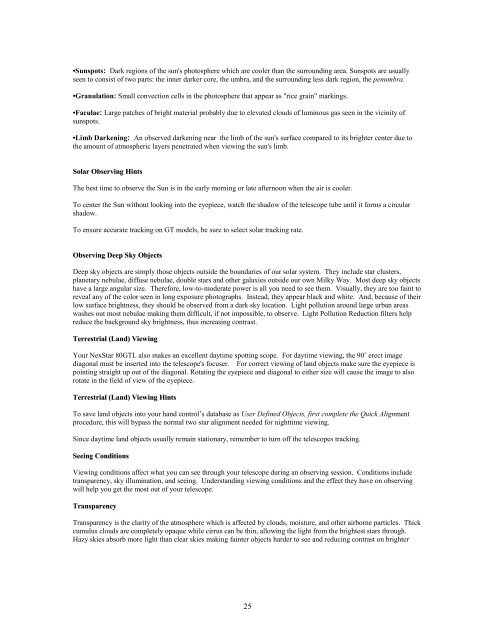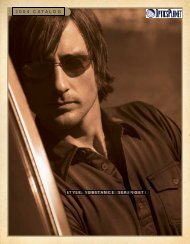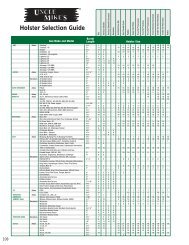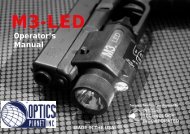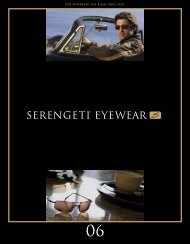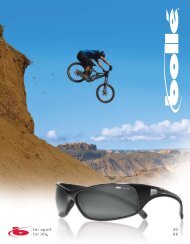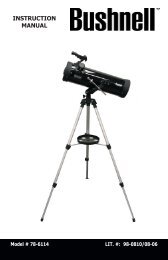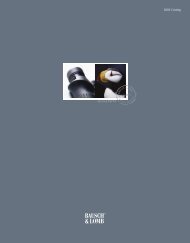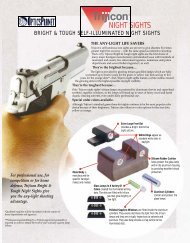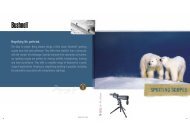INSTRUCTION MANUAL NexStar 80GTL - Celestron
INSTRUCTION MANUAL NexStar 80GTL - Celestron
INSTRUCTION MANUAL NexStar 80GTL - Celestron
You also want an ePaper? Increase the reach of your titles
YUMPU automatically turns print PDFs into web optimized ePapers that Google loves.
•Sunspots: Dark regions of the sun's photosphere which are cooler than the surrounding area. Sunspots are usually<br />
seen to consist of two parts: the inner darker core, the umbra, and the surrounding less dark region, the penumbra.<br />
•Granulation: Small convection cells in the photosphere that appear as "rice grain" markings.<br />
•Faculae: Large patches of bright material probably due to elevated clouds of luminous gas seen in the vicinity of<br />
sunspots.<br />
•Limb Darkening: An observed darkening near the limb of the sun's surface compared to its brighter center due to<br />
the amount of atmospheric layers penetrated when viewing the sun's limb.<br />
Solar Observing Hints<br />
The best time to observe the Sun is in the early morning or late afternoon when the air is cooler.<br />
To center the Sun without looking into the eyepiece, watch the shadow of the telescope tube until it forms a circular<br />
shadow.<br />
To ensure accurate tracking on GT models, be sure to select solar tracking rate.<br />
Observing Deep Sky Objects<br />
Deep sky objects are simply those objects outside the boundaries of our solar system. They include star clusters,<br />
planetary nebulae, diffuse nebulae, double stars and other galaxies outside our own Milky Way. Most deep sky objects<br />
have a large angular size. Therefore, low-to-moderate power is all you need to see them. Visually, they are too faint to<br />
reveal any of the color seen in long exposure photographs. Instead, they appear black and white. And, because of their<br />
low surface brightness, they should be observed from a dark sky location. Light pollution around large urban areas<br />
washes out most nebulae making them difficult, if not impossible, to observe. Light Pollution Reduction filters help<br />
reduce the background sky brightness, thus increasing contrast.<br />
Terrestrial (Land) Viewing<br />
Your <strong>NexStar</strong> <strong>80GTL</strong> also makes an excellent daytime spotting scope. For daytime viewing, the 90˚ erect image<br />
diagonal must be inserted into the telescope's focuser. For correct viewing of land objects make sure the eyepiece is<br />
pointing straight up out of the diagonal. Rotating the eyepiece and diagonal to either size will cause the image to also<br />
rotate in the field of view of the eyepiece.<br />
Terrestrial (Land) Viewing Hints<br />
To save land objects into your hand control’s database as User Defined Objects, first complete the Quick Alignment<br />
procedure, this will bypass the normal two star alignment needed for nighttime viewing.<br />
Since daytime land objects usually remain stationary, remember to turn off the telescopes tracking.<br />
Seeing Conditions<br />
Viewing conditions affect what you can see through your telescope during an observing session. Conditions include<br />
transparency, sky illumination, and seeing. Understanding viewing conditions and the effect they have on observing<br />
will help you get the most out of your telescope.<br />
Transparency<br />
Transparency is the clarity of the atmosphere which is affected by clouds, moisture, and other airborne particles. Thick<br />
cumulus clouds are completely opaque while cirrus can be thin, allowing the light from the brightest stars through.<br />
Hazy skies absorb more light than clear skies making fainter objects harder to see and reducing contrast on brighter<br />
25


